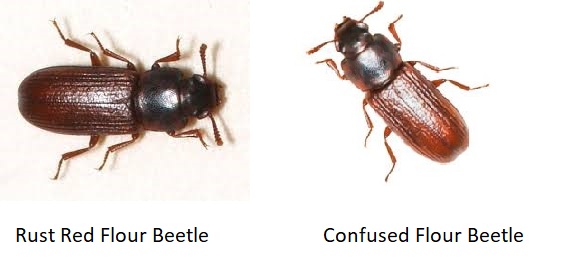Dr David Wood BVSc, MRCVS
Stored concentrates, like milled or whole grains and manufactured feed have always been subject to infestation by insect pests which have adapted to live in, on and around the contents of your feed bin.
Infestation can occur anywhere from the point of manufacture through the wholesaler’s store to the stock feed shop and your own feed room. Often only microscopic eggs are present, and the retailer may be quite unaware of a problem. Most businesses handling feed have a program of pest control to reduce contamination by means of regular fumigation and spraying but re-infestation is common and it’s virtually impossible to totally eliminate these pests for long.
Probably the most common insect pests of horse feed are the two members of the Tribolium family of flour beetles, the red or rust red and the confused flour beetle, aptly named because it’s so often confused with the red ones!

Both are 3-5mm long and have larvae which look like little maggots up to 6mm long. Another family member produces the larvae called mealworms bred commercially for use as bait by fisherman and as a tasty snack for pet lizards. They are cold intolerant and tend to die out over winter. Since the females can lay up to 400 eggs which hatch in 4-8 weeks, they can soon appear in vast numbers if not controlled. Fortunately, they seem to be quite harmless to horses, but they do cause some damage to pellets etc. and some effort should be made to control them.
Weevils
Famed as an extra source of protein in the ship’s biscuit of old, the female’s bore holes into grains like corn, wheat, oats and barley and lay their eggs inside so the developing larvae can hatch in safety and chomp their way out. They are known to attack pasta so if you find tiny holes in your spaghetti, you got weevils! The rice weevil and the granary weevil, both 3-4mm long, are the most common and again, they won’t bother horses which consume a few.

There are other similar insect pests, beetles and borers but the above seem to be the most common and they are all subject to similar control measures. Good hygiene in the feed room with careful cleaning out of bins and sweeping shelves and dark corners clear of feed debris is the first line defense. Insect sprays can be useful on surfaces but do not spray directly onto exposed feed and avoid spray drift – apart from being toxic the chemicals smell strongly, and horses will reject feed contaminated by insecticides far more than feed infested with bugs. For silos and infested stores, a suitable fumigant like Phosphine from Aluminum Phosphide tablets (Fostoxin/Phostoxin) may be used but is highly toxic and requires extreme caution employing suitable safety signage, personal protective equipment (PPE) and strict adherence to label directions. Fumigation usually requires sealed closure of the space for calculated fumigation, ventilation and withholding periods which may total up to a couple of weeks. If unsure, professional advice should be sought.
So, these little tiny critters are aptly named ‘’pests’’ but fortunately they don’t eat much and if the numbers are controlled our horses seem to tolerate them far better than we do.

